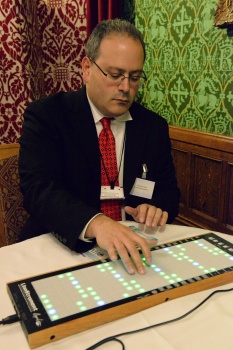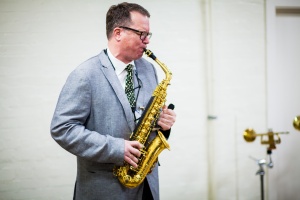The OHMI Trust: enabling music making

The OHMI Trust’s driving objective is to remove the barriers to music-making faced by people with physical impairments. Musical instruments that can be played without two fully-functioning hands and arms are rare, denying full participation in musical life to the millions who may have a congenital impairment, or been injured, suffered a stroke, or perhaps developed arthritis. Yet, with the right instrument designs, these physical barriers can be overcome.
OHMI’s instruments are primarily sourced through its annual international competition. The competition challenge is to create or adapt instruments so they can be played without the use of one hand and arm and, crucially, without limiting their potential for virtuosity. The winning technical solutions can then be reworked for a variety of physical impairment. Entries are received from around the world in all the competition categories.
Over the five years the competition has been running, the OHMI Trust has acquired most of the brass family, as well as flutes, clarinets, saxophones, recorders, and even bagpipes and guitars. OHMI awards have also been given to electronic instruments, where they are capable of accurately emulating a traditional instrument.
As the instruments become available, the OHMI Trust has begun teaching disabled children through its Music Makersprogrammes. Many of the instruments used are made widely available through the OHMI hire scheme. Trumpets and recorders are the most popular starter instruments, but its award-winning one-handed clarinet, designed and built by Peter Worrell, is one of several instruments capable of taking players to the highest level of virtuosity.

To support its work, the OHMI Trust will hold a major conference on music and disability on September 7th and 8th 2018 in Birmingham. It’s being organised in collaboration with Birmingham City University and Queen Mary University of London, both of which are also partners in OHMI research programmes into the issues it’s addressing.
OHMI’s research includes pedagogic studies into instrument teaching practices for disabled people, questions around the effects of early experiences of music, and even 3D printing of music instruments. The latter is an important element of OHMI’s work, recognising that our instruments, usually being made by individual artisans, are often expensive and in short supply. At the time of writing, we are about to launch a complete 3D-printed one-handed descant recorder – costing less than half that of the traditionally-made instrument.
Some OHMI Award Winners
To meet the OHMI challenge, instruments have to enable people with physical impairments to participate fully in mainstream music-making. In one respect, electronic instruments have an advantage in that they can be reconfigured for any physical characteristics. But if full participation is to be achieved, they also have to sound exactly like one of the traditional instruments that are the mainstay of most music ensembles. Added to this, the directness with which traditional instruments respond the player is extremely difficult to emulate with most electronic devices.

The OHMI Award-winning LinnStrument, designed and built by Roger Linn in the USA, has gone further than most in achieving the demands of the competition. You could call it an expressive alternative to the MIDI keyboard controller. It does not itself generate sounds but, rather, sends standard MIDI messages to any MIDI sound generator or software. But that’s where any similarity ends. Unlike a MIDI keyboard’s simple on/off switches, the LinnStrument’s multi-touch technology captures three dimensions of each finger movement polyphonically, creating a far greater degree of musical expression than can be achieved on any MIDI keyboard. In addition, the LinnStrument’s keys are arranged not as on a piano but, like stringed instruments, with multiple rows (strings) consisting of 2 octaves of semitones. The rows can be tuned in fifths as a guitar, in fourths as a violin or cello, or to any interval desired. All this adds up to an electronic instrument with expressive control approaching that of fine acoustic instruments, responding musically to subtle inputs and personal playing styles.

The recorder is one of the most common starter instruments for children. For that reason alone, the development of a one-handed version makes it an extremely important addition to OHMI’s instrument collection. It works by adding mechanical key-work that gives the player access to the notes that the missing hand would fulfil. Thus, the full range of the recorder is possible. This brilliant key-work is made by the English instrument maker, Peter Worrell.
This beautiful instrument, also designed and built by Peter Worrell, was made from scratch for a one-handed musician. It is not an adapted instrument. As with any standard clarinet, it has a fully chromatic range, from Low E to High F. The key-work can be mirrored for right hand or left-hand models, and even tuning is designed to be one-handed. The entire instrument is handmade in Peter’s workshop in Norfolk to the highest specifications. The clarinet body, bell and barrel are made from African blackwood (the traditional choice of clarinet makers), the key work is silver-plated, and the pads are premium deluxe leather pads. It is an instrument capable of taking the most talented player to the highest levels of virtuosity.

This remarkable instrument was developed with an American professor of music, David Nabb, together with the instrument maker, Jeff Stelling. David suffered a serious stroke that left him without the use of his left hand and arm; but now, with the Toggle-key Saxophone, he has been able to recover all his previous virtuosity. The instrument works by carrying keying action for the various standard registers to multi-function “toggle keys” that can be easily operated by one hand. Once mastered, the instrument has all the dexterity of the best traditional saxophones.
Many brass instruments can be played with the aid of a secure stand to take their weight, allowing free operation of the valves while also resisting embouchure pressure. The trombone and larger brass instruments generally fit this description. Trumpets are a little more difficult though as, for more advanced players, simultaneous manipulation of the 3rd and 1st value slides is also necessary. The OHMI trumpet stand is highly effective for holding the instrument, and provides flexibility for embouchure changes, while electronic and mechanical devices are in development for the operation of slides. Examples of the stands can be seen in the accompanying video.
Further information on all OHMI’s work can be found on their website.




